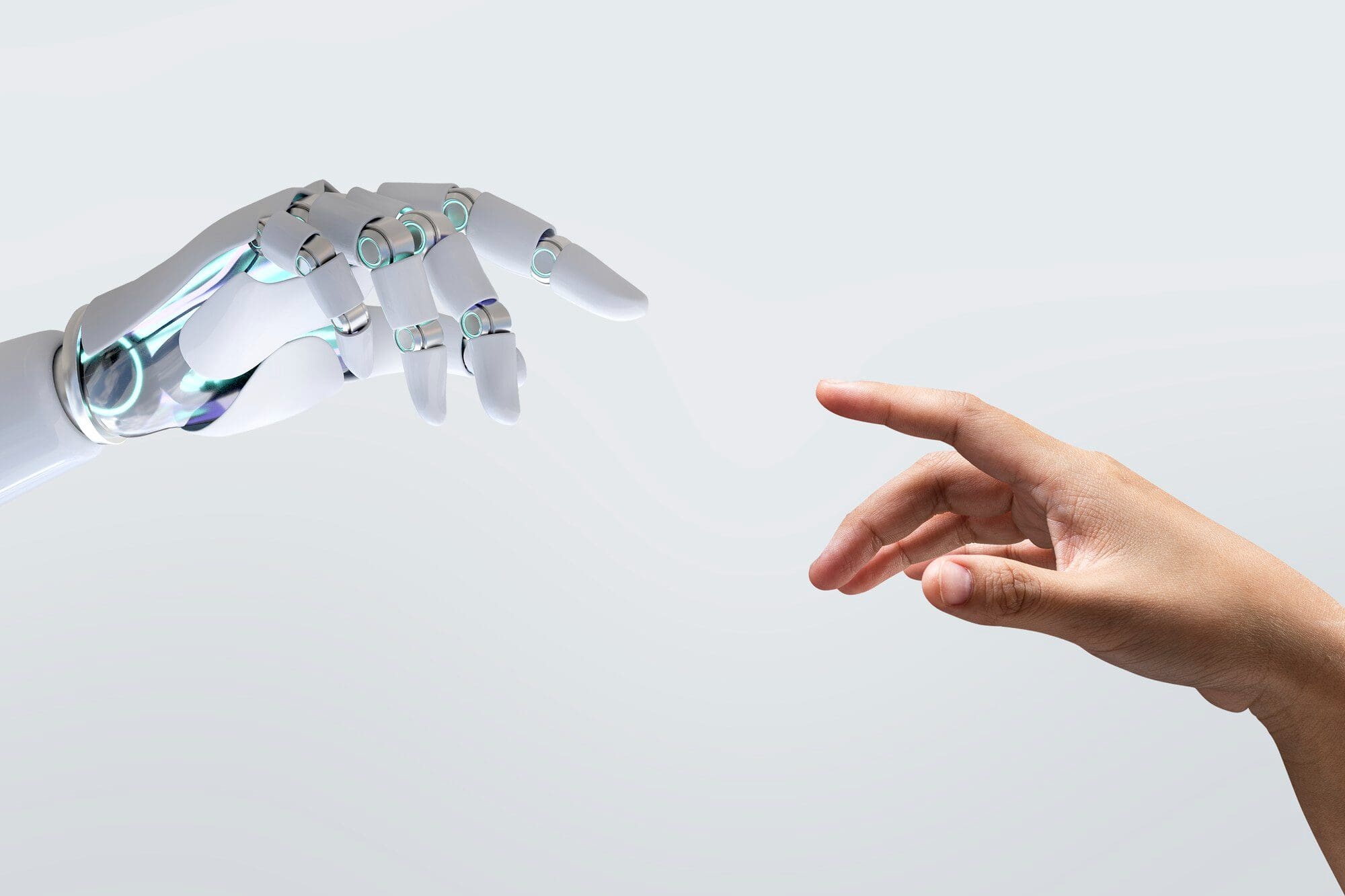
Image by rawpixel.com on Freepik
Artificial Intelligence has become more prominent than ever, and its development is only increasing. Why going up? With the recent advancement of generative AI, every individual, research group, and company is racing to become the best in the field, which makes things more competitive. Although, it’s sometimes hard to follow all the latest trends.
To summarize the AI trend in 2023 further, the AI Index Report is created. The Stanford Institute for Human-Centered Artificial Intelligence (HAI) developed the report with a steering committee from various academic and industry fields, and the report's result is intended to give the decision-maker and the audience action to advance AI responsibly and ethically.
What are the trends and key takeaways from this report? Let’s discuss them.
AI Index Report 2023
The AI Index Report 2023 is the sixth edition of the report, and it focuses much on AI development with its impact on human society. With data curated from various experts and analyzed rigorously, here are the key takeaways from the report.
Industry Gets Ahead of Academia
According to the report, many significant machine learning systems released in 2022 are spearheaded by the industry field instead of academia. A significant machine learning system is a model included in the Epoch Dataset and has specific criteria such as improvement of the state-of-the-art methodology.
In 2022, 38 significant machine learning systems were released, but 32 of them were produced by the industry. We can refer to the chart below to see how the trend in 2022 has shifted compared to 2014.
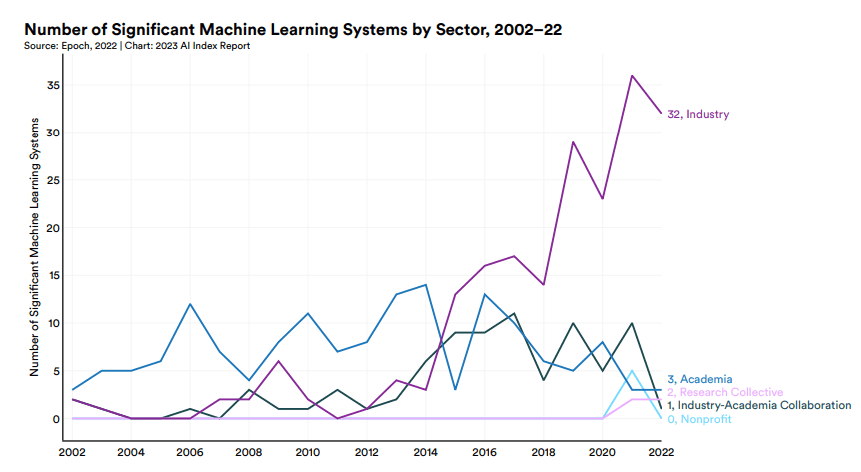
Image adapted from AI Index Report 2023
Saturation on the Traditional Benchmark Performance
Many machine learning models were tested yearly against a standard benchmark dataset to see if their model could improve the current benchmark performance. For example, the image classification task using ImageNet dataset or the English language understanding task using the SuperGlue benchmark.
However, the amount of performance increases each year is become smaller and is considered to reach the plateau. The chart below shows that the YoY improvement for many benchmarks is less than 5%.
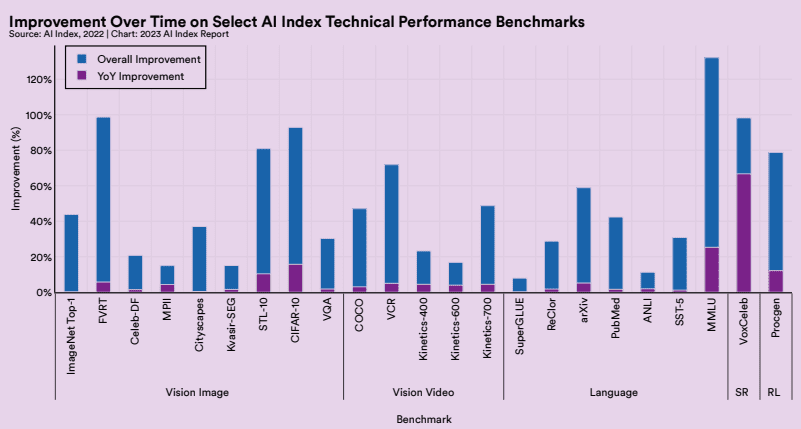
Image adapted from AI Index Report 2023
To mitigate the benchmark saturation case, researchers recently launched new comprehensive benchmarks such as BIG-bench and HELM. Although, most of this new benchmark is focused on the Large Language Model tasks as it’s the current trend.
AI is both helping and harming the environment
Recent research has shown that the select large language model could negatively impact the environment by emitting carbon emissions above any other human activity. The image below shows that GPT-3 model emits carbon emissions almost 500 times more than regular air travel for one passenger.
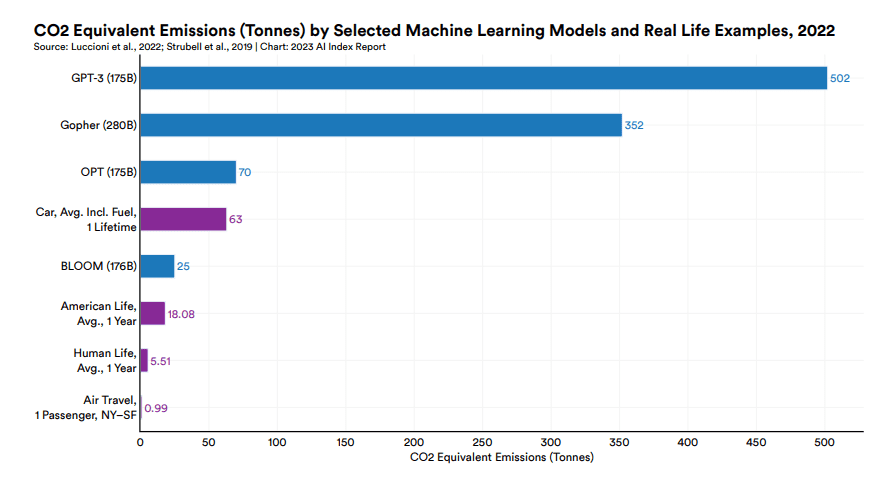
Image adapted from AI Index Report 2023
However, there is also research that proves AI could also save the environment. Research by DeepMind in 2022 shows a machine learning agent called BCOOLER could efficiently improve energy-saving systems within the Google Data Center by 12.7%.
AI Rapidly Accelerates Scientific Progress
In 2022, AI has been shown to contribute to many scientific breakthroughs, including:
- DeepMind researchers created a reinforcement learning algorithm to find the best methods for managing plasma produced for nuclear fusion in a system called tokamaks.
- Fawzi et al. (2022) discovered a new algorithm for matrix manipulation using reinforcement learning called AlphaTensor.
- Nvidia discovered a new way to improve the chip systems by allowing AI to design the systems using reinforcement learning.
- Shanehsazzadeh et al. (2023) develop new de novo antibody discovery systems using zero-shot Generative AI.
Increase in the number of incidents concerning the misuse of AI
With the new development of AI, the number of misuses is expected to increase. According to the AIAAIC database, the number of incidents in 2021 is 26 times higher than in 2012. The trends can be seen in the image below.
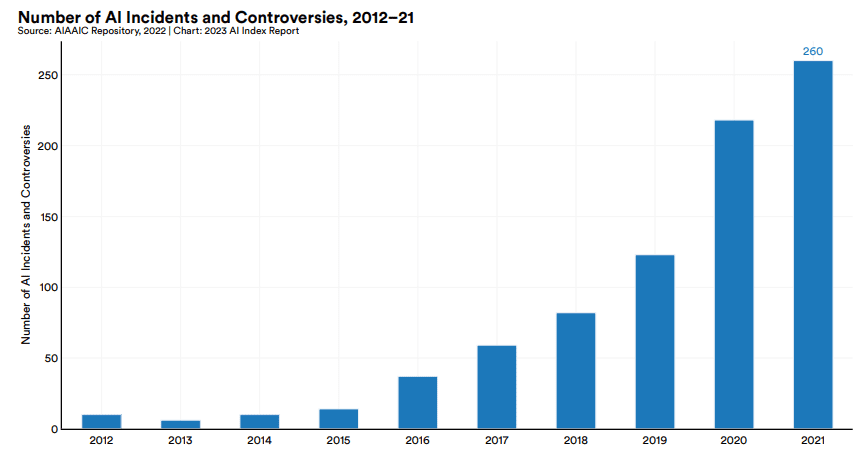
Image adapted from AI Index Report 2023
Controversies example is the case of Ukrainian President Zelenskyy's deepfake surrender case and Intel’s development of a student emotion monitoring system.
The rising cases also suggest that people's awareness is higher than in previous years, improving the tracking of AI misuse.
The demand for AI-related professional skills is increasing
The need for AI-related skills in job postings has increased over the years and across countries. It’s shown that many companies show more interest in AI implementation within their organization. The data come from Lightcast below shows an upward trend for the number of job postings with AI-related skills.
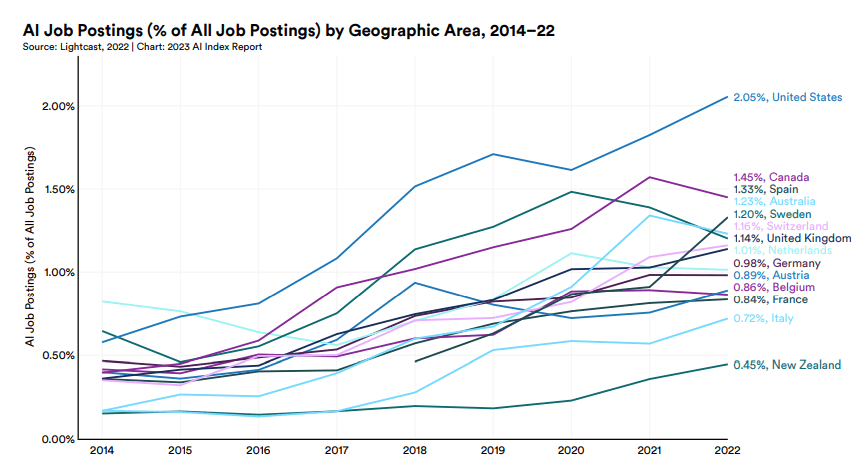
Image adapted from AI Index Report 2023
The data above also shows that the United States leads in percentage wise for the country that requires AI skills, and New Zealand is the lowest. Although the data is only limited to the selected country, so tread wisely.
2022 Showed a decrease in AI private investment
In 2022, there is $91.9 billion in investment to AI-related investment. According to the data by NetBase Quid, the number shows a decrease compared to the year 2021, although it’s still 18x higher than in 2013. The data can be seen in the chart below.
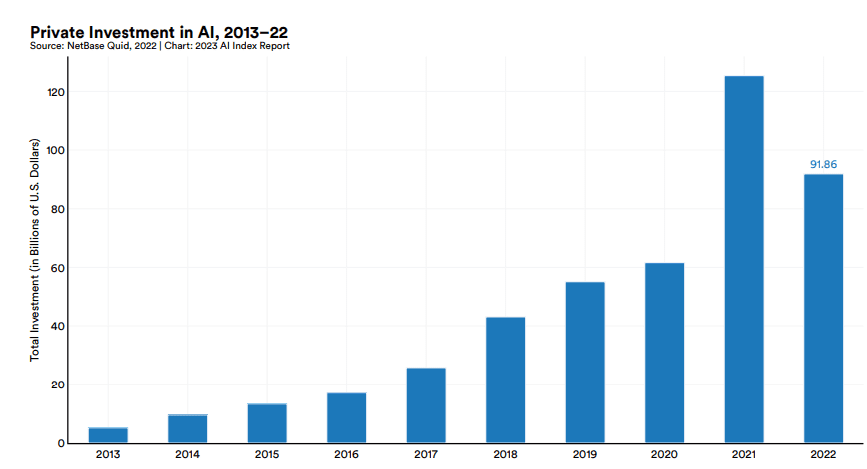
Image adapted from AI Index Report 2023
It’s a short-term decrease, but the trend still increases in the long run. This shows that many companies are still willing to invest in AI development.
While the proportion of companies adopting AI has plateaued, the companies that have adopted AI continue to pull ahead.
Despite AI adoption rates plateauing, companies that have adopted AI keep advancing
According to the McKinsey report, around 50% of the surveyed companies adopted AI in their business functions as of 2022. The chart below shows that adoption is plateaued around 50-60% since 2019, although the number is much higher than in 2017.
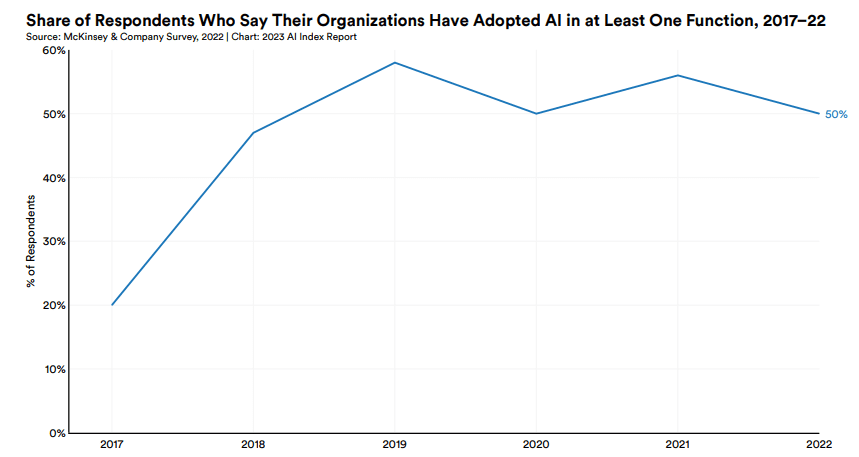
Image adapted from AI Index Report 2023
The finding shows that companies are still willing to adopt AI within their business and organization, although the number might stay around 50% for years to come.
There is an increasing trend in policymakers' interest in AI
According to the AI Index research of 127 countries' legislative bodies regarding AI, 31 countries have passed AI-related bills, and in total, there are 123 AI-related bills from these 31 countries. The number of AI-related bills in 2022 is 37, compared to 2016, when only 1 bill passed. The trend can be seen in the image below.
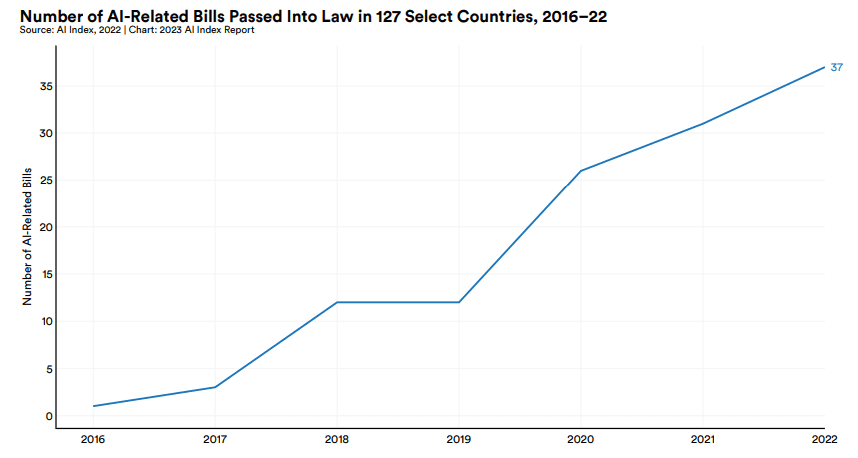
Image adapted from AI Index Report 2023
The data above shows that many countries have realized how AI can be used in many areas; however, the adoption needs regulation to avoid misuse.
Globally, people have started to see the benefits of AI adoption
From the survey conducted by IPSOS to 28 Countries with 19504 adults of varying ages, more than 50% understand how artificial intelligence works and believe AI will change everyday life in the next 3-5 years. The complete data can be seen in the chart below.
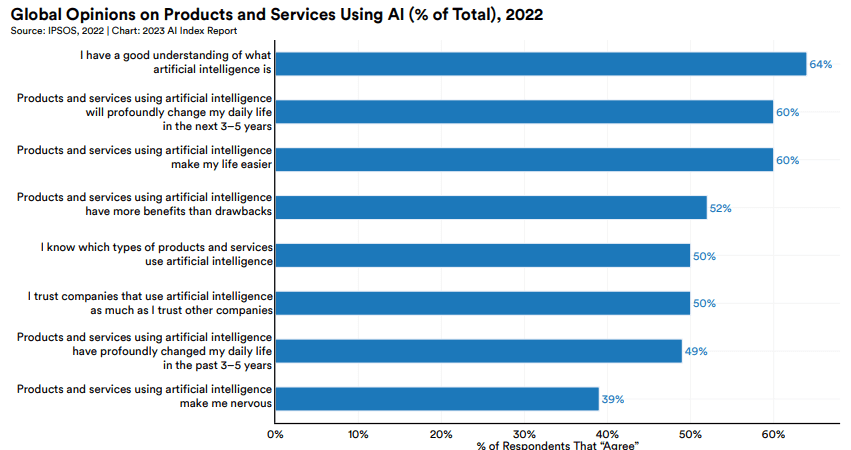
Image adapted from AI Index Report 2023
The number of individuals who believe AI is useful is high, showing that AI slowly would integrate into people’s everyday lives. Although, some still show that AI makes them nervous, which is normal.
Conclusion
AI trend is rising and might stay that way for years to come. This trend is proven by the AI Index Report, which shows the key takeaways:
– Industry Gets Ahead of Academia
– Saturation on the Traditional Benchmark Performance
– AI is both helping and harming the environment
– AI Rapidly Accelerates Scientific Progress
– Increase in the number of incidents concerning the misuse of AI
– The demand for AI-related professional skills is increasing
– 2022 Showed a decrease in AI private investment
– Despite AI adoption rates plateauing, companies that have adopted AI keep advancing
– There is an increasing trend in policymakers' interest in AI
– Globally, people have started to see the benefits of AI adoption
Cornellius Yudha Wijaya is a data science assistant manager and data writer. While working full-time at Allianz Indonesia, he loves to share Python and Data tips via social media and writing media.
- Overview of the AI Index Report: Measuring Trends in Artificial…
- What To Expect for AI Quality Trends In 2023
- Introducing The NLP Index
- 5 Key Data Science Trends & Analytics Trends
- Future Says Series | Discover the Future of AI
- What to Expect From Your Career Path as a Data Scientist